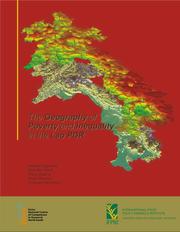
Geography of poverty and inequality in the Lao PDR
By Michael Epprecht
Subjects: Regional disparities, Poverty, Equality, Income distribution, Economic conditions
Description: This study presents estimates of various measures of poverty and inequality in the Lao PDR at a high level of spatial disaggregation. Highly detailed information on the spatial distribution of welfare across the country has been developed through the application of small-area estimation techniques on a combination of information from the 2003 Lao Expenditure and Consumption Survey and from the 2005 Population and Housing Census. The analysis confirms that poverty incidence tends to be highest in mountainous areas, and further reveals that the poorest areas are found in the mountains of the southern part of the country. Nevertheless, the greatest numbers of poor people live in the lowland areas of the Mekong River corridor, where the population density is much higher than that of the sparsely populated upland areas. An analysis of various geographic factors, including access to markets, reveals that both accessibility and agro-climatic variables are able to explain to a large extent the differences in rural poverty rates, and indicates that poverty in the remote areas is linked to low agricultural potential and lack of market access. Improved access to markets, however, has the strongest pro-poor effect in areas where poverty rates are lowest, and agricultural production is most intensive. Since many poverty alleviation programs of the Lao PDR are geographically targeted, the results from this study can serve as an important source of information in order to improve the targeting of these programs by making use of more precise estimates of poverty at the district and village level.
Comments
You must log in to leave comments.